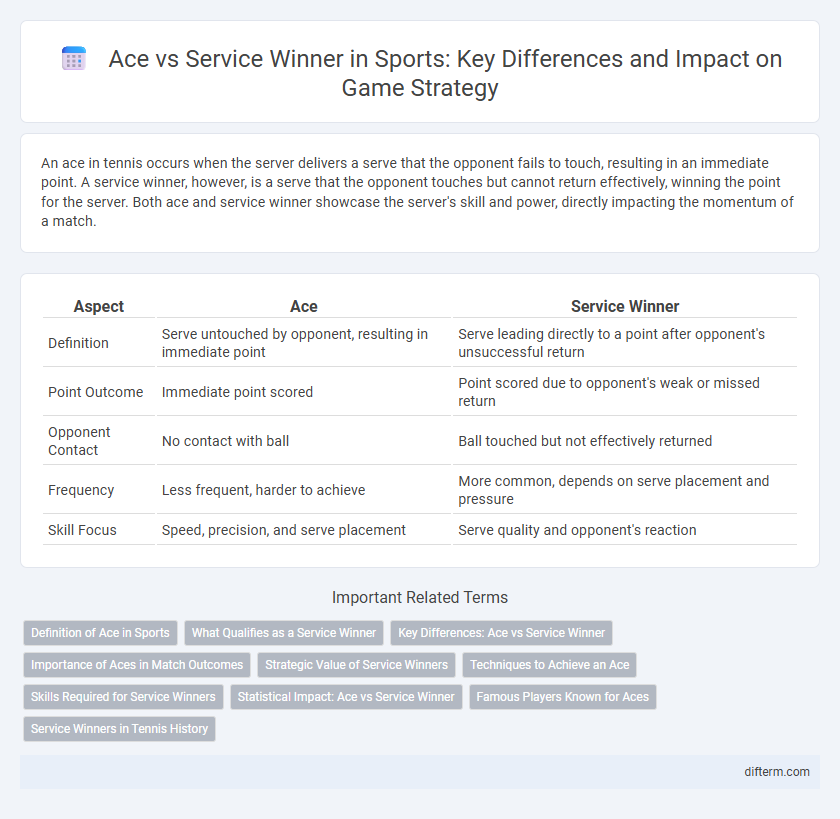An ace in tennis occurs when the server delivers a serve that the opponent fails to touch, resulting in an immediate point. A service winner, however, is a serve that the opponent touches but cannot return effectively, winning the point for the server. Both ace and service winner showcase the server's skill and power, directly impacting the momentum of a match.
Table of Comparison
| Aspect | Ace | Service Winner |
|---|---|---|
| Definition | Serve untouched by opponent, resulting in immediate point | Serve leading directly to a point after opponent's unsuccessful return |
| Point Outcome | Immediate point scored | Point scored due to opponent's weak or missed return |
| Opponent Contact | No contact with ball | Ball touched but not effectively returned |
| Frequency | Less frequent, harder to achieve | More common, depends on serve placement and pressure |
| Skill Focus | Speed, precision, and serve placement | Serve quality and opponent's reaction |
Definition of Ace in Sports
An ace in sports, particularly in tennis and volleyball, is a serve that lands directly in the service box without being touched by the opponent, resulting in an immediate point. Unlike a service winner, which may include unreturned serves or rallies won after the serve, an ace signifies the server's complete dominance by preventing any contact. This skillful and precise action demonstrates exceptional control and power, often shifting momentum in competitive matches.
What Qualifies as a Service Winner
A service winner in tennis occurs when the serve sets up a point that the server wins without the opponent making a valid return, with the key difference from an ace being that the ball is touched by the returner but not returned effectively. Service winners rely on strategic placement, speed, and spin to force a weak return or an outright error, contributing significantly to a player's dominance on serve. Tracking service winners is crucial in match statistics as they reflect both the quality and effectiveness of a player's serve beyond unreturned aces.
Key Differences: Ace vs Service Winner
An ace is a serve that lands in the service box without being touched by the opponent, resulting in an immediate point, whereas a service winner includes any serve that, after contact, leads directly to a point usually by forcing a weak return or an error. Aces reflect flawless serve execution and are a pure indicator of service dominance, while service winners demonstrate strategic placement and power to gain an advantage during the rally's start. Understanding the distinction helps in analyzing a player's serving effectiveness and tactical approach.
Importance of Aces in Match Outcomes
Aces play a critical role in tennis match outcomes by providing players with direct points that exert pressure on opponents and boost confidence. Unlike service winners that may include errors or rallies, aces ensure an unequivocal advantage by delivering unreturnable serves. Statistics reveal that players with higher ace counts often dominate matches, underlining the strategic importance of powerful and precise serving in competitive play.
Strategic Value of Service Winners
Service winners offer significant strategic value by forcing opponents into defensive positions and disrupting their rhythm, which can lead to easier points in subsequent rallies. Unlike aces, which rely primarily on power and precision to end points immediately, service winners often incorporate placement, spin, and variation to exploit weaknesses and set up tactical advantages. Players who master service winners can control the pace of the match and increase pressure, ultimately enhancing their overall performance.
Techniques to Achieve an Ace
Mastering the serve toss and generating maximum racket head speed are crucial techniques to achieve an ace in tennis. Players focus on placement by targeting service box seams and exploiting opponents' weaker returns to increase the likelihood of an ace. Combining spin variation, such as topspin or slice, with precise footwork enhances control and power, resulting in a higher ace count during matches.
Skills Required for Service Winners
Mastering service winners demands precise ball placement, exceptional swing speed, and keen anticipation to exploit opponent weaknesses. Players must develop advanced racket control and the ability to generate unpredictable spins to keep the receiver off balance. Consistent practice in reading opponent positioning and adapting serve techniques is essential for maximizing service winner success.
Statistical Impact: Ace vs Service Winner
Aces significantly boost a player's service efficiency, often resulting in an immediate point with zero response from the opponent, reflected in higher serve win percentages. Service winners, while also contributing to points won on serve, usually require some form of opponent interaction but demonstrate aggressive serve placement and tactical prowess. Statistical analysis reveals that matches with higher ace counts correlate strongly with service dominance and overall match control.
Famous Players Known for Aces
Roger Federer, known for his precise and powerful serving, has amassed numerous aces throughout his career, showcasing his dominance on grass courts. Serena Williams, with her aggressive serve speeds, consistently produces aces that put opponents on the defensive early in matches. John Isner holds the record for the most aces in a single match, emphasizing the critical role of service dominance in tennis.
Service Winners in Tennis History
Service winners in tennis history are shots where the server's delivery immediately wins the point without requiring further play, showcasing exceptional precision and power. Legendary players like Pete Sampras and Serena Williams have recorded high counts of service winners, contributing significantly to their dominance on the court. These aggressive serves disrupt opponents' rhythm and set the tone for remarkably effective service games.
ace vs service winner Infographic

 difterm.com
difterm.com